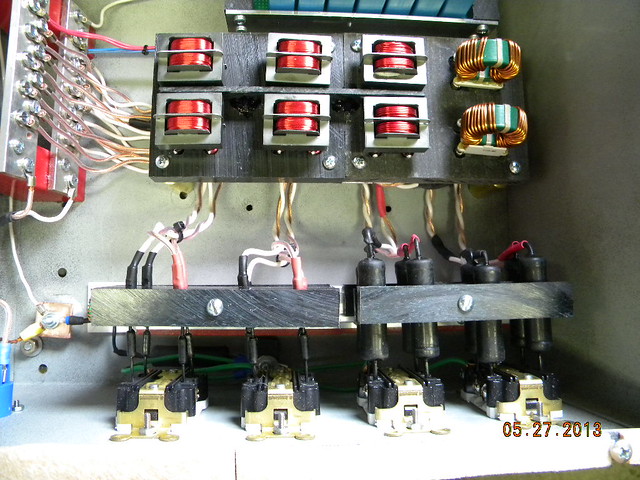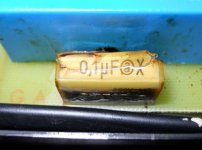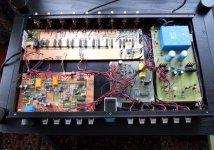10000 + 10000 uF at 1 V (the diode) and 50 Hz = 1.57 amps only or 3.14 amps if you have two diodes. The rest of the current will go through the diodes
Only very big toroids (500V plus) have big problems. There is a lot of RFI\EMI on mains.
I measured the capacitance from primary to secondary on a 60 W toroid (2X120//2*60): more than 2 nF. 😱
All EI cores and specially R-cores have low cross-winding capacitance. So a filter that 'synchronizes' any residue such that is disappears is great to have then.
Plus: Toroids do saturate even witha few mA. this might then even worden their behavior maybe.
It's more about the caps ability to handle ripple and the physical size being able to dissipate heat.You'll need only 10 or 16 Volts caps since you have only 1-2 volts across them. It's also better to have more capacitance because the filter will be more effective.
If you can get in to the circuitry of the amp, you then have the capability to add a half-wave rectified capacitor filtered DC load with a switch to change which side of the mains sinewave is loaded - with the intent of neutralising the mains DC component that is upsetting the toroid. This may be a reasonable option if you consistently get a mechanical hum from the toroid, as that would indicate that your house/site has a persistent mains DC bias problem.
exactly.
i added a DC blocker to my amp some years ago and the only change I heard was absolutely NO toroid hum anymore.
which is exactly i wanted and I am very happy 😉
mlloyd1
i added a DC blocker to my amp some years ago and the only change I heard was absolutely NO toroid hum anymore.
which is exactly i wanted and I am very happy 😉
The DC creates only a mechanical sound in the transformer itself. This hum can be really annoying in a quiet room.
mlloyd1
btw, i "thought" that r-core transformers were much less sensitive to the DC problem than toroids.
anyone know the facts?
mlloyd1
anyone know the facts?
mlloyd1
Rcore are very similar to toroid in that they use a continuous strip to wind the core.
That continuous strip is VERY efficient in controlling and using the flux that runs around the magnetic circuit.
I would expect the DC tolerance to be very similar.
The high frequency performance of the toroid comes in part from the over-winding of the primary and secondary layers.
If this is copied in your Rcore then they too will have similar high frequency performance.
However, some Rcore separate the primary from the secondary, by putting them on the opposing "legs" of the core. This will almost certainly reduce the HF performance
That continuous strip is VERY efficient in controlling and using the flux that runs around the magnetic circuit.
I would expect the DC tolerance to be very similar.
The high frequency performance of the toroid comes in part from the over-winding of the primary and secondary layers.
If this is copied in your Rcore then they too will have similar high frequency performance.
However, some Rcore separate the primary from the secondary, by putting them on the opposing "legs" of the core. This will almost certainly reduce the HF performance
transistormarkj said:An Audio Placebo
Thank you for sharing idea about three MOV's.
Inside a unit, MOV's from power line Hot or Neutral to chassis are generally a bad idea.
Bill Whitlock often writes on this subject.
Bill Whitlock often writes on this subject.
MOV's are installed accross the line and after a fuse or a breaker,
they are consumables, once they get fried, they must be replaced...
if they fail they create a loud bang, but sometimes even with a loud
bang, the circuit still functions...this is my experience with them...
they are consumables, once they get fried, they must be replaced...
if they fail they create a loud bang, but sometimes even with a loud
bang, the circuit still functions...this is my experience with them...
5cent X rated cap seems too cheap.
These are guaranteed by performance and I can't see how they can be produced that cheaply and still be guaranteed to meet the duty.
X1, or X2, across the L & N rails.
Y1, or Y2, across L & E and across N & E
These are guaranteed by performance and I can't see how they can be produced that cheaply and still be guaranteed to meet the duty.
X1, or X2, across the L & N rails.
Y1, or Y2, across L & E and across N & E
5cent X rated cap seems too cheap.
These are guaranteed by performance and I can't see how they can be produced that cheaply and still be guaranteed to meet the duty.
X1, or X2, across the L & N rails.
Y1, or Y2, across L & E and across N & E
Two weeks ago I dug an old preamp out of the loft and within minutes the room was filled with smoke. A class X cap had gone up. It didn't go short unbelievably but its a cautionary tale.
The cap is in the corner next to the tranny. Its when something like this happens you realise how important safety is such as proper grounding of the casework etc. That cap could easily have bulged and contacted the case.
Attachments
Mooly,
this is a common failure I often experience with older test equipment, Philips stuff is especially prone to that. Have the same type of X-cap as shown in your picture, known as "marshmallows"
The problem is these X-caps develop micro-cracks over time (decades) which allows moisture to get in. Of course at the time they were produced they passed all tests but this was in the early days of using plastics for component enclosures when the knowledge about the aging characteristics was still poor.
As a rule, I replace mains X or Y caps on any equipment older than 10 yrs or of unknown history.
this is a common failure I often experience with older test equipment, Philips stuff is especially prone to that. Have the same type of X-cap as shown in your picture, known as "marshmallows"
The problem is these X-caps develop micro-cracks over time (decades) which allows moisture to get in. Of course at the time they were produced they passed all tests but this was in the early days of using plastics for component enclosures when the knowledge about the aging characteristics was still poor.
As a rule, I replace mains X or Y caps on any equipment older than 10 yrs or of unknown history.
5cent X rated cap seems too cheap.
These are guaranteed by performance and I can't see how they can be produced that cheaply and still be guaranteed to meet the duty.
X1, or X2, across the L & N rails.
Y1, or Y2, across L & E and across N & E
X2 caps - I have a few bags of em and I'm cheap so they HAD to be pretty cheap. Box-type metalized polypropylene film capacitor(MKP). I put them on all my gear even add them to gear I don't build myself. I hang them off the back of the IEC socket (power off everything at the wall when not listening). I just checked I paid $.14 a piece for a bag of 25, they gotta be the cheapest caps I've bought.
Cheers,
Bob
Mooly,
this is a common failure I often experience with older test equipment, Philips stuff is especially prone to that. Have the same type of X-cap as shown in your picture, known as "marshmallows"
The problem is these X-caps develop micro-cracks over time (decades) which allows moisture to get in. Of course at the time they were produced they passed all tests but this was in the early days of using plastics for component enclosures when the knowledge about the aging characteristics was still poor.
As a rule, I replace mains X or Y caps on any equipment older than 10 yrs or of unknown history.
Thanks. That sounds a probable scenario as the preamp has been in the loft for 6 or 7 years I guess, and was built around 14 years ago and the cap would have been older than that.
Why does an X1 or X2 capacitor show only X ?
All my stock include the 1 in the X1 label.
I thought they had to be labeled correctly to show they had passed the testing.
All my stock include the 1 in the X1 label.
I thought they had to be labeled correctly to show they had passed the testing.
There is never a reason not to have a power conditioner.
But, there are componets I don't like. I won't deal with ferrite, MOV's, or active anything.
I make conditioners in a range of possible componets. High end to low end. Currently made by order, like this high end unit. (please note the copper block for ground was swapped to an isolated configuration at that point)

There's stuff you can't see, like you can almost see the bank of capacitors that does a lot of filtration, and then another capacitor setup in a Y configuration but only on neutral and ground. They do cost a lot to purchase. There just isn't a way around it. That being said, some companies prices appear to exceed a concievable markup I can understand. You don't want to know what this one costs with the Bybee's added.
I can tell you that CMC/DMC's work great when sized right. Capacitors are nothing but pure magic (X or Y rated). However compression and current capabilities are key. Skimpy stuff equals skimpy sound. Bybee's are personal taste, but they work, for a pretty incredible price anyway.
But, there are componets I don't like. I won't deal with ferrite, MOV's, or active anything.
I make conditioners in a range of possible componets. High end to low end. Currently made by order, like this high end unit. (please note the copper block for ground was swapped to an isolated configuration at that point)

There's stuff you can't see, like you can almost see the bank of capacitors that does a lot of filtration, and then another capacitor setup in a Y configuration but only on neutral and ground. They do cost a lot to purchase. There just isn't a way around it. That being said, some companies prices appear to exceed a concievable markup I can understand. You don't want to know what this one costs with the Bybee's added.
I can tell you that CMC/DMC's work great when sized right. Capacitors are nothing but pure magic (X or Y rated). However compression and current capabilities are key. Skimpy stuff equals skimpy sound. Bybee's are personal taste, but they work, for a pretty incredible price anyway.
Last edited:
The DC creates only a mechanical sound in the transformer itself. This hum can be really annoying in a quiet room.
Agree too, but sometimes DC can have other unpleasant consequences: when i installed my Buffalo Dac i was very pleased with the sound only to find out it would loose sync each time i switched the lights- very annoying. TP support forums hinted at a DC blokker to prevent this and I installed one. No more unlocks. This was in a recent appartement, electrical wiring was fine.
I moved now and it's a permanent feature on the dac, even if I'm not sure if there is any dc here.
OT but as amateur/ hobbyist the situation is very frustrating, i can see 20+ wireless networks in my neighborhood, I had to accept PLC now that i live in family with teenagers, low energy lamps and you name it you got it. It's like eating food that you know has been irradiated. (/OT)
- Home
- Amplifiers
- Power Supplies
- DC blockers and mains filters

